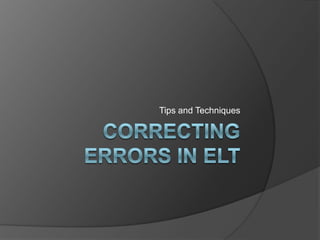Report
Share

Recommended
More Related Content
What's hot
What's hot (20)
Book review on approaches and methods in language teaching

Book review on approaches and methods in language teaching
The definition of CLT By Alireza Sadeghiyan - www.academia.edu

The definition of CLT By Alireza Sadeghiyan - www.academia.edu
Oral approach and situational language teaching - ELT

Oral approach and situational language teaching - ELT
The Natural Approach | Methods and Approaches of Language Teaching 

The Natural Approach | Methods and Approaches of Language Teaching
Viewers also liked
Viewers also liked (20)
Techniques in Teaching English as a Second Language

Techniques in Teaching English as a Second Language
Similar to Correcting errors in elt
Similar to Correcting errors in elt (20)
Importance of feedback in teaching and learning languages

Importance of feedback in teaching and learning languages
More from Dylan Gates
More from Dylan Gates (10)
10-step guide to teaching effective conversation classes

10-step guide to teaching effective conversation classes
Supportive observations in English Language Teaching

Supportive observations in English Language Teaching
Recently uploaded
Mehran University Newsletter is a Quarterly Publication from Public Relations OfficeMehran University Newsletter Vol-X, Issue-I, 2024

Mehran University Newsletter Vol-X, Issue-I, 2024Mehran University of Engineering & Technology, Jamshoro
Making communications land - Are they received and understood as intended? webinar
Thursday 2 May 2024
A joint webinar created by the APM Enabling Change and APM People Interest Networks, this is the third of our three part series on Making Communications Land.
presented by
Ian Cribbes, Director, IMC&T Ltd
@cribbesheet
The link to the write up page and resources of this webinar:
https://www.apm.org.uk/news/making-communications-land-are-they-received-and-understood-as-intended-webinar/
Content description:
How do we ensure that what we have communicated was received and understood as we intended and how do we course correct if it has not.Making communications land - Are they received and understood as intended? we...

Making communications land - Are they received and understood as intended? we...Association for Project Management
Recently uploaded (20)
Basic Civil Engineering first year Notes- Chapter 4 Building.pptx

Basic Civil Engineering first year Notes- Chapter 4 Building.pptx
Sensory_Experience_and_Emotional_Resonance_in_Gabriel_Okaras_The_Piano_and_Th...

Sensory_Experience_and_Emotional_Resonance_in_Gabriel_Okaras_The_Piano_and_Th...
UGC NET Paper 1 Mathematical Reasoning & Aptitude.pdf

UGC NET Paper 1 Mathematical Reasoning & Aptitude.pdf
On National Teacher Day, meet the 2024-25 Kenan Fellows

On National Teacher Day, meet the 2024-25 Kenan Fellows
General Principles of Intellectual Property: Concepts of Intellectual Proper...

General Principles of Intellectual Property: Concepts of Intellectual Proper...
Making communications land - Are they received and understood as intended? we...

Making communications land - Are they received and understood as intended? we...
Unit 3 Emotional Intelligence and Spiritual Intelligence.pdf

Unit 3 Emotional Intelligence and Spiritual Intelligence.pdf
ICT role in 21st century education and it's challenges.

ICT role in 21st century education and it's challenges.
Correcting errors in elt
- 2. Types of errors Slips – Wrong language caused by tiredness, nerves, lack of concentration. All native speakers make slips. Example – “I didn’t do nothing. I mean anything.”
- 3. Mistakes L2 speakers use incorrect grammar, vocabulary and pronunciation. They might be able to correct “wrong” language themselves If they can, the mistake is not serious
- 4. Errors Sometimes students cannot correct “wrong” language. They may not know the correct form. They may have learned an incorrect form
- 5. What do we correct? If we correct every incorrect utterance, how will the learner feel? Discouraged, grateful, confused, nervous….
- 6. Correction Rule 1 If the incorrect language results in communication breakdown, we should try to correct it.
- 7. Correction Rule 2 If a student makes a mistake with the target language in a controlled practice / accuracy task, we should correct it.
- 8. Correction Rule 3 If a student makes a mistake during a freer practice / fluency task, we may choose not to correct it or we may note down error and correct it later
- 9. Correction Steps 1. See if the student can correct their own mistake 2. See if another student can correct the mistake 3. Correct the mistake
- 10. Correction Strategies Example mistake: “Yesterday, I visit my mother.”
- 11. Gestures / Facial expressions Open hand, rotation wrist, palm down A wave of the finger A shake of the head A frown A backwards thumb gesture to remind student to use past form
- 12. Direct Correction Echoing – repeat what student said but stress incorrect word “Yesterday, I VISIT my mother.” Bleeping – “Yesterday, I ____ my mother.” Reformulation – “Yesterday, I visited my mother.”
- 13. Summary Mistakes are natural and are signs that learning is taking place. Encourage self and peer correction before teacher correction Use a variety of techniques Make sure students understand why the mistake was made Get students to produce correct form
